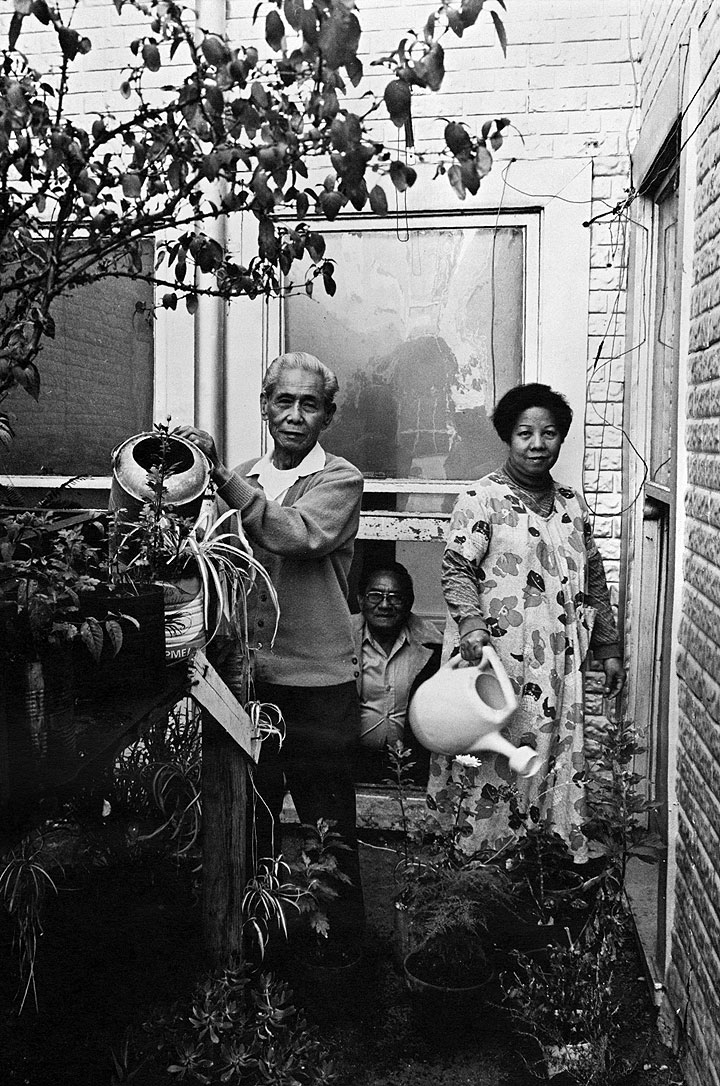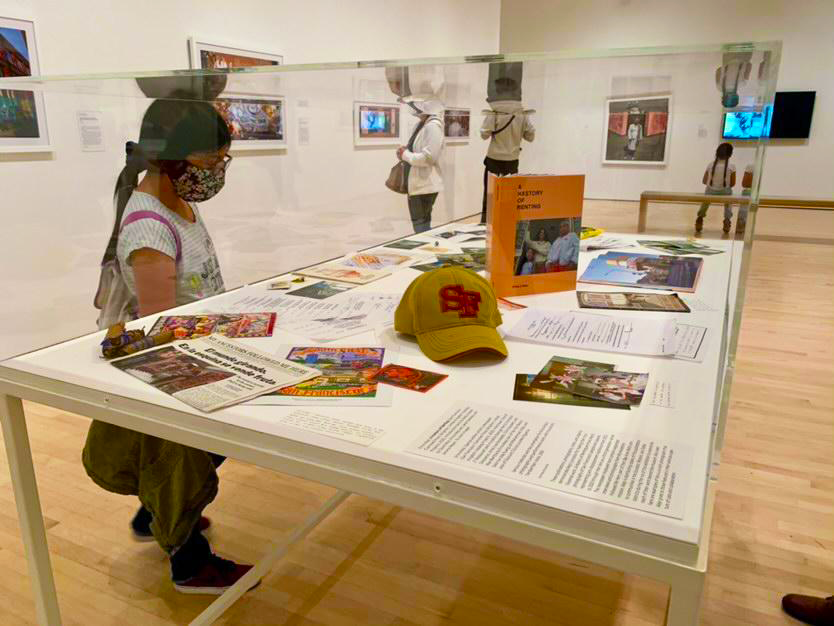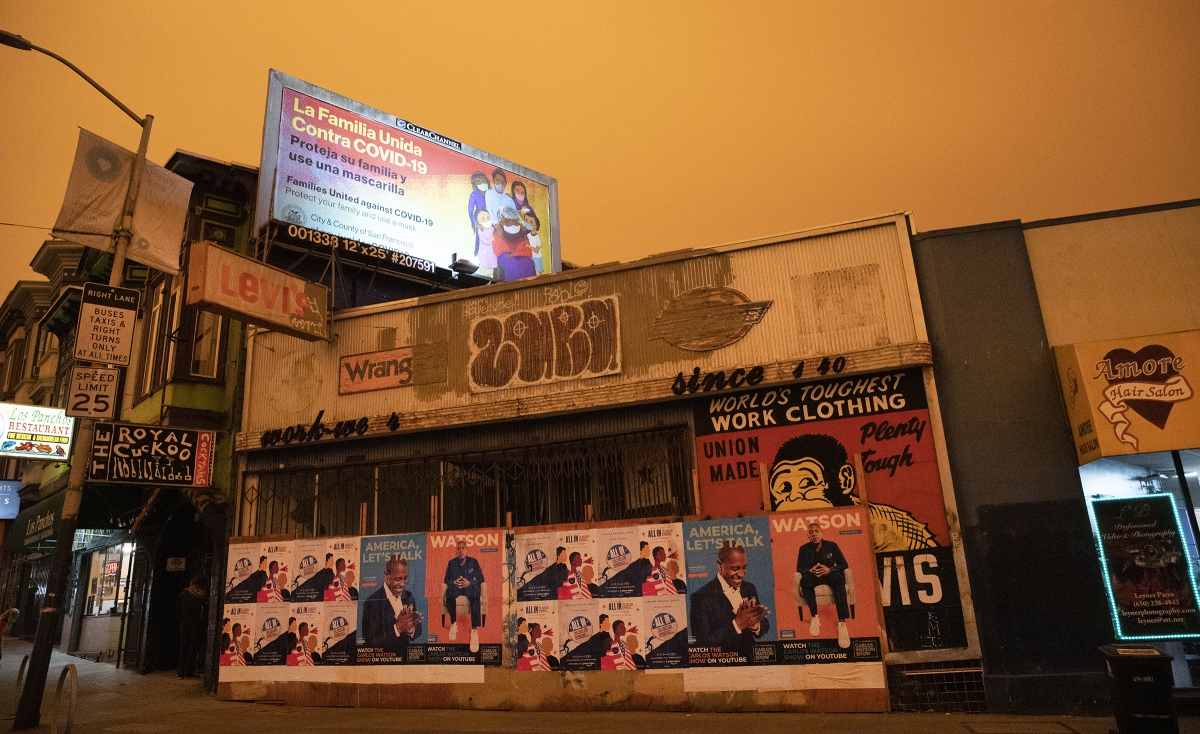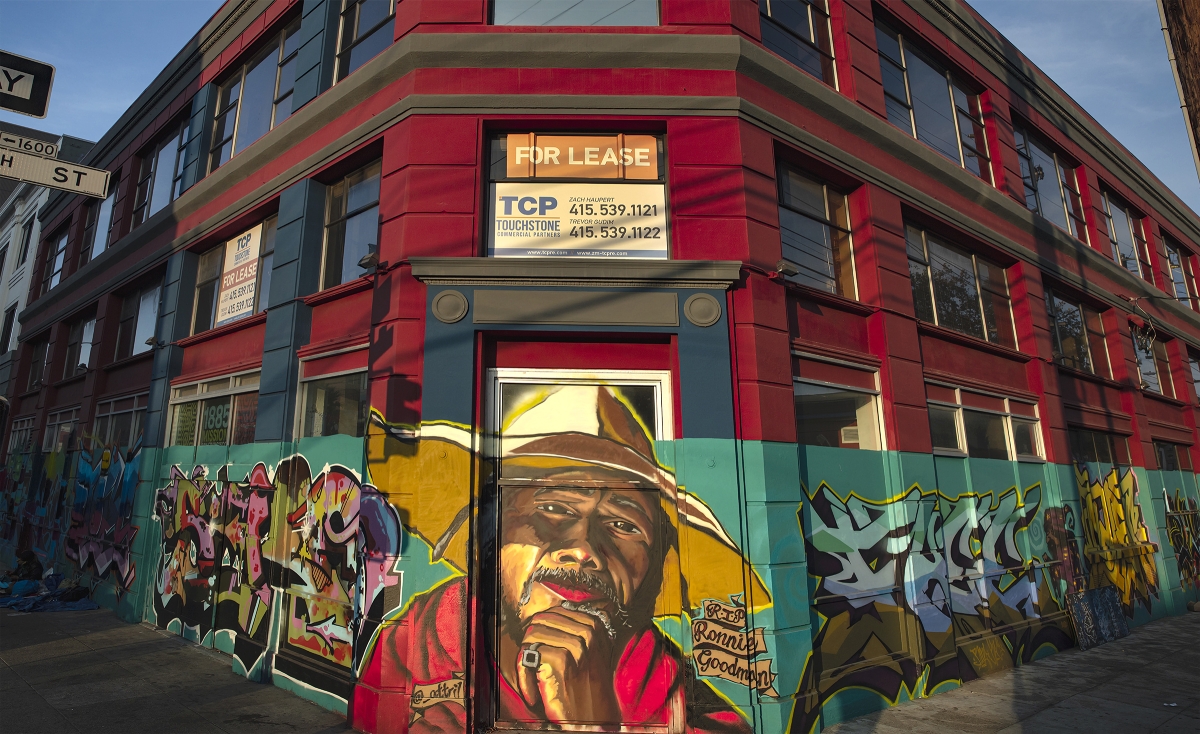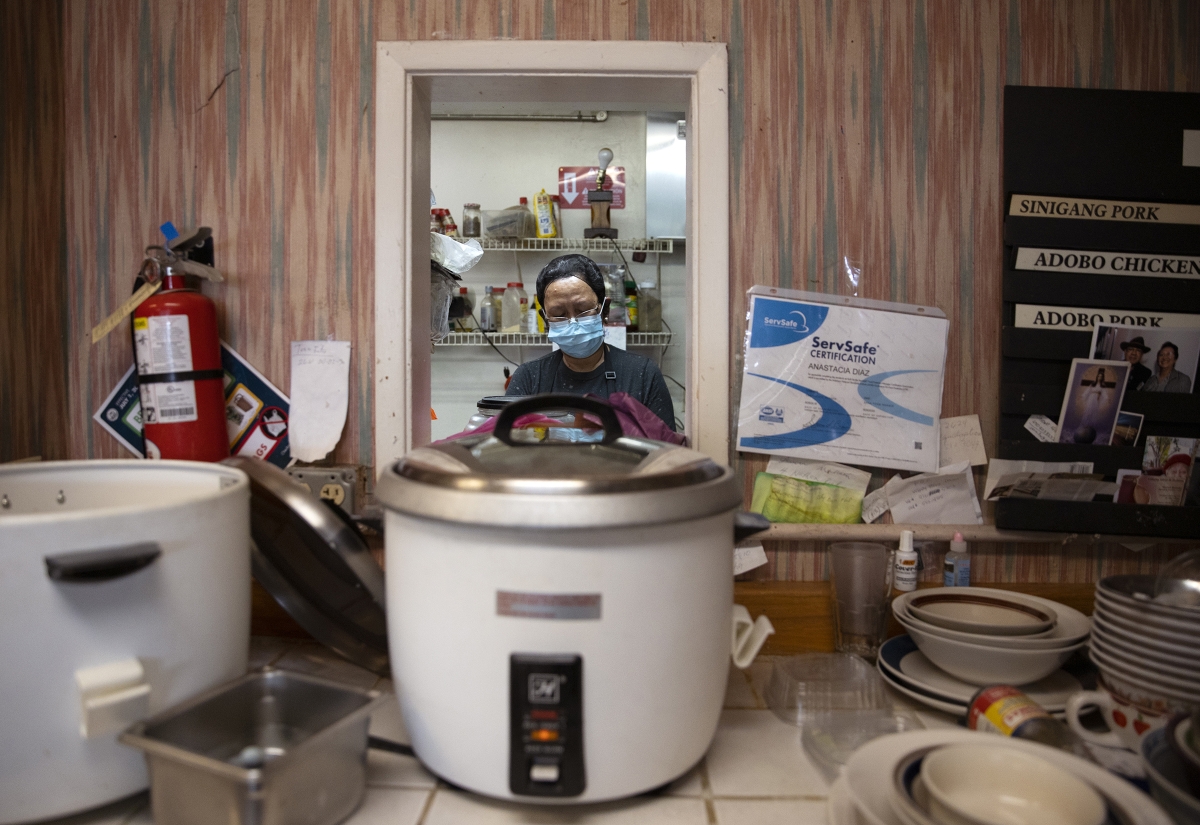In fall 2020, as COVID-19 continued its global spread, I set out on foot to document San Francisco’s Mission Street.[1] While I had walked the street countless times as a third-generation renter growing up in the Excelsior, Mission, and South of Market districts, this trek felt different through my lens as a photographer and researcher. As part of my artistic process, I recorded what I saw on the 7.2-mile meditative walk: shuttered storefronts doubling as murals, continued gentrification, and community elders grappling with new catastrophes and older, enduring injustices.
My documentation of life along Mission Street developed into My Ancestors Followed Me Here, commissioned as part of the Bay Area Walls initiative at the San Francisco Museum of Modern Art, which was exhibited from March to September 2021 alongside Oakland-born artist Adrian L. Burrell’s response to the pandemic. [2] Here, I reflect on the ancestors, legacies, and parallel histories that inform the project and my artistic practice grounded in care, community action, and cultural preservation.
Ancestors, Legacies, and Parallel Histories
Image 1. L-R: Claudio Domingo, Anacleto Moniz, and Luisa De La Cruz (R) tend a garden in the second-floor light well of the International Hotel, San Francisco, circa 1970s. Photograph by Crystal K. Huie. Courtesy of the Huie Estate and Manilatown Foundation.
San Francisco, 1970s: the elderly, immigrant, and Filipino Manong tenants of the International Hotel, also known as the I-Hotel, at 868 Kearny Street were the focal point of a community fight for housing justice against urban renewal in an already redlined city and neighborhood. Facing eviction threats since 1968, the residents, with support from community advocates, organized and negotiated for their residence at I-Hotel until their violent eviction facilitated by riot police—met with fierce community resistance—on August 4, 1977.
The city did not relocate the 200 residents; they became scattered across the Bay Area. It fell upon the grassroots work of community advocates to support the now unhoused residents. The single room occupancy (SRO) residence was demolished, with plans to erect in its place another parking garage to benefit the financial district perimeters. For 30 years, the lot of the former I-Hotel remained empty. Decades of advocacy by organizers who were also participants of the multiethnic, intergenerational, and cross-class activism of the Third World Liberation Front Strikes of 1968–69—namely, poet Al Robles (1930–2009), scholar Dr. Estella Habal, activist Emil De Guzman, and photographers Tony Remington and Crystal K. D. Huie—facilitated the reclamation of the lot as senior and low-income housing, establishing the Manilatown Heritage Foundation as the ground floor community center.[3] [4]
Amid the residents’ traumatic eviction process were also peaceful moments, including a moment photographed by Crystal K. D. Huie: Filipino elders Claudio Domingo, Anacleto Moniz, and Luisa De La Cruz tending to plants on the second floor light well space between their SRO units. [See Image 1.] Research with curator Lian Ladia through Dr. Habal’s writings provided insight on Luisa De La Cruz, also known as “Mrs. D.”[5] She was an activist and organizer who provided a homelike atmosphere for the elderly long-term residents by bringing in plants to cultivate an inner-city garden between their rooms. Mrs. D. rarely spoke at rallies, but within the lives of the tenants she contributed to the activist prism in the I-Hotel struggle. Ancestors like Mrs. D. embody the process of solidarity work. Their forced eviction for the sake of “urban renewal” reflects our fight for a future that puts people first.
A Hxstory of Renting
Image 2. Front cover of A Hxstory of Renting (2020). Courtesy of the artist.
Reflecting on our histories as people-centered—from housing justice to light well gardens—is at the heart of A Hxstory of Renting, a precursor to My Ancestors Followed Me Here. Through public interventions, photographs, installations, and a publication, I look at the issue of housing as a human right through my ethnographic lens as a third-generation Filipino-American renter in my birthplace, San Francisco.
Comprising my photography taken in 2015–2020, the book focuses on three San Francisco neighborhoods experiencing gentrification at different rates: the Excelsior, Mission, and South of Market. All three are connected by Mission Street, a commercial and public transportation corridor as well as ground zero for tech-fueled urban renewal projects. My perspective as a Filipino-American, subtly expressed in the book’s photographs, brings the Filipino experience to the nuanced discussion of the housing affordability crisis.
Image 3. Organizers Jeantelle Laberinto and Mary Claire Amable holding a protest sign at the Little Masantol eviction, July 3, 2018, from A Hxstory of Renting (2020). Courtesy of the artist.
In one photo, two organizers, Jeantelle Laberinto and Mary Claire Amable, hold up a sign, hand-painted by Amable, with an arrow indicating, “EVICTOR OF FAMILIES THIS WAY.” [See Image 3] They directed attention to the July 2018 actions supporting three multigenerational Filipino families who ultimately were evicted through the Ellis Act by a private landlord from their decades-long homes at 657-659 Natoma Street, known as “Little Masantol.” While San Francisco high-rise buildings surround Laberinto and Amable, their bold statement and stances defy being overshadowed, marking a painful yet necessary part of Filipino and city history to learn from.[6] [7]
Essays contributed by community organizer David Woo, photographer Janet Delaney, artist Jerome Reyes, and me punctuate the book, grounding the visuals in personal and community histories. Woo’s introductory essay contextualizes the photographs in San Francisco’s post-war period, when private interests, with the government’s backing, eyed lucrative advancements through urban renewal projects to develop the city as the economic and financial headquarters of the Western Pacific Rim. These forces continue to impact BIPOC (Black, Indigenous, and People of Color), immigrant, working and middle-class communities, which remain de-prioritized and constantly face threats of and actual displacement, especially in neighborhoods examined in the book.
Yet, as observed by Woo, this city-wide corporate restructuring through high-rise office development and the building of the grid of freeways gave rise to ongoing neighborhood-based opposition movements, including by communities residing in these districts. “Organizing is how we fight back,” Woo writes. The book expands on the people-centered resistance for housing justice through my writing on my family’s Bay Area renting history since 1959, interviews with Delaney on our photographic practices, Reyes’s observations on my photographs, and the thoughtful book design and editing by Jerlyn Jareunpoon-Phillips and Lian Ladia.
The social realistic tone of the book begins with the urgent documentation of my late aunt’s posthumous eviction from her apartment of 25 years. The images that follow this grim sequence—seemingly desolate spaces, abandoned objects, other families moving out—reflect shared anxieties on displacement and gentrification. These are anxieties my own family and I have faced every day and every year for the past three generations: our perpetual reality as renters, dating back to 1959 when my great-aunt Marina Chioco Peña moved to a two-bedroom apartment with her late husband and children in the East Bay’s Pittsburg Marina. Despite constant feelings of impermanence, I’m learning about the beauty, stillness, and power families like mine have through our history of renting, documented through archived rental agreements and water bills, stacks of photos developed from disposable cameras, and oral histories of past neighbors and landlords.
A Hxstory of Renting begins in the typical pathological lens of displacement and gentrification (i.e., problematizing the issue and creating victims of all those affected, yet offering no cultural context and solution voiced by the very people affected) and progressively decenters this perspective towards the end. The book looks toward the community power and resilience of youth and families who live, breathe, eat, play, sing. In these sequences are watermelon-eating contests by gleeful children, New Year’s Eve karaoke sessions in family garages, and renters who are women organizers leading community actions against a developer using the Ellis Act to evict the multigenerational Masantol families. We are the masses of people who embody the potentialities in neighborhood-based grassroots organizing against displacement. Meditating on five years’ worth of photographic archives on one street in my neighborhood allowed me time to look more deeply at Mission Street, especially at the height of the COVID-19 pandemic and social uprisings in summer 2020.
My Ancestors Followed Me Here
Image 4. Liz’s children, Lucy and Hayden (Erina’s neighbors), visit Erina and Adrian’s exhibitions at SFMOMA. Courtesy of the artist with parent permission.
To begin My Ancestors Followed Me Here, I composed a set of instructions in the form of a Fluxus score to map out my sensory parameters as a pedestrian engaging with storefronts, essential workers, and artists impacted by multiple pandemics and injustices:[8]
1. Trek Mission Street on foot, only;
2. Get to know people, places, and objects;
3. Refrain from taking a photo until you’ve deeply connected with the person, place, or object–with their consent and trust.
My journey was archived at SFMOMA through seven photographs, along with wall texts that feature excerpts from multilingual community testimonies gathered with interlocutors Vida Kuang and Lourdes Figueroa. A display case features additional mementos and grassroots organizing materials from my collaborations with SOMA Pilipinas Filipino Cultural Heritage District and the Communities United for Health and Justice alliance at Poder SF. Audiences also experienced a newspaper of the featured artists and service workers, designed by Jerlyn Jareunpoon-Phillips, and a short film created with Peggy Peralta, Nix Guirre, and Dorothy Lee. Viewed together, the multimedia installation is an extension of my practice of protecting local histories with community members. To the fullest way possible in the spirit of coalition building, I wanted to preserve the histories of essential workers and muralists whose work brings life to the arterial street.
Image 5. Former site of Arik Surplus Co., known for carrying Ben Davis work clothes, 2650 Mission Street, Mission district, from the series My Ancestors Followed Me Here, 2020; inkjet print; courtesy of the artist; © Erina Alejo
Accompanying the visual documentation of the Mission Street storefronts were interviews of the muralists who painted the shuttered buildings, amassing a trove of documentation about artworks that, by their nature, often elude archival treatment. I learned about the dynamic ways muralists use public space, including shuttered storefronts in the Mission district, to honor ancestors.
On the first day of my photographic journey, September 9, 2020, the day of the orange skies during the California wildfires, I took a portrait of a shuttered business that sold work-wear, indicated by hand-painted logos on part of the storefront’s façade: Levis, Wrangler, and Ben Davis. Investigation into the lot connected me to the site’s integral role in San Francisco’s working-class history. The lot, 2650 Mission Street, was the former site of Arik Surplus Co., iconic specifically for its hand-painted Ben Davis sign representing San Francisco blue-collar families. Local artists and residents reconnected me to artists George Harry Crampton-Glassanos and Charlie Ertola, who are part of the community restoring the beloved Ben Davis-brand sign throughout the decades. “If you’re from SF, there is a good chance you know that these types of signs are sacred,” George Harry Crampton-Glassanos explains in our interview transcript and film. “It was something Charlie and I did for the community—a rogue act. We did not want credit or recognition.” [See Image 5.]
Image 6. Mural of Ronnie Goodman (1960–2020) by Max Marttila, 1885 Mission Street, Mission district, from the series My Ancestors Followed Me Here, 2020; inkjet print; courtesy of the artist; © Erina Alejo
Image 7. Mural of Breonna Taylor and Eyad al-Hallaq by Chris Gazaleh, 537 Valencia Street, Mission district, from the series My Ancestors Followed Me Here, 2020; inkjet print; courtesy of the artist; © Erina Alejo
Serendipitously meeting artist Max Marttila painting a mural on Valencia Street led me to another one of his large-scale murals on the exterior of 1885 Mission Street. His mural honors Ronnie Goodman, an unhoused Mission resident who died in 2020. Along with Max, Ronnie was part of the Precita Eyes family as an artist and muralist who created art with the organization and contributed to community-based neighborhood projects in the Bay Area, including San Francisco’s Mission District.[9] [10] “He talked a lot about growing up in the city, and, particularly, prison and how the homeless should be cared for,” Marttila recalled. [See Image 6.] Back on Valencia Street, Chris Gazaleh shows us the global scope of police brutality on Black and Palestinian communities through his mural of Breonna Taylor and Eyad al-Hallaq, expanding, “I literally pulled up on that wall and started painting it. No one was gonna stop me. I can’t live another day without seeing this connection being made.” [See Image 7.]
Image 8. Tess of JT Restaurant preparing daily servings of home-style Filipino cuisine, 953 Mission Street, South of Market district, from the series My Ancestors Followed Me Here, 2020; inkjet print; courtesy the artist; © Erina Alejo
The indigenous Filipino ideology of togetherness, known as kapwa, and in motion (as a verb): pakikipagkapwa, became my truth and portal in interviewing essential workers along Mission Street. In Tagalog, I learned from Tita Tess Diaz about her work ethic at JT Restaurant in SOMA Pilipinas: “We were raised to know hard work. In 2003, my parents visited me. They saw me cooking at 4AM until dark. Sometimes, it’s just naps. My father wept, ‘I didn’t know you toiled this way. That you slept so little, like a roach.’ My father’s words remain unforgettable.” [See Image 8.]
Image 9. Anh Huynh of Yan Yan Beauty Salon cutting artist and collaborator Vida Kuang’s hair, 4619 Mission Street, Excelsior district, from the series My Ancestors Followed Me Here, 2020; inkjet print; courtesy the artist; © Erina Alejo
In Cantonese, my collaborator Vida Kuang and I connected with Excelsior’s Yan Yan Beauty Salon owner Anh Huynh about immigrating to the United States after Liberation Day in Ho Chi Minh City, Vietnam, as Huynh cut Kuang’s hair. She opened the salon twenty years ago. “I can have my own freedom when I open my own business,” Huynh told us. “I work for no one else but myself.” [See Image 9.]

Image 10. Prudencia Ayala (pseudonym) (at right) on shift at Discount City, 2784–2786 Mission Street, Mission district, from the series My Ancestors Followed Me Here, 2020; inkjet print; courtesy the artist; © Erina Alejo
In getting to know the workers at Mission District’s Discount City, collaborator Lourdes Figueroa and I learned to embrace their refusal to be interviewed as a community right to self-representation. Implementing anthropologist Zora Neale Hurston’s ethnographic technique of interpreting a cultural event through her own voice, Figueroa then documented our time at Discount City through a Spanish and English participatory observational account. [See Image 10.]
My project encompasses text and long-form interviews, visuals, audio recording, and material archives to create a multisensorial record of life along Mission Street. I decided to further archive the project into a newspaper and film to make it accessible to the very people centered in my work, who may never be able to set foot in the museum. The hard copy newspaper features parts of the community conversations and additional insight from local cultural anchors Anna Lisa Escobedo and Sita Kuratomi Bhaumik. Both entries elucidate the complexity of photography and storytelling, and the layered practice of creating and circulating images through the same vocabulary and rhythm used to capitalize on tragedy, including wildfires, documentation of police brutality, and abuse of power.[11] The film accompanies the viewer on their ride on the 14 Mission MUNI bus as they travel to each featured site to meet the artists and service workers.
It was a privilege to have this commission at a time of hardship for families, small business workers, and artists, many of whom are immigrants, working- and middle-class along Mission Street. This time also marked a rupture in trust between arts institutions and our communities as we radically reconsider their role in structural violence and inequity impacting our lives. It was my conscious decision to complete this commission, believing that it’s meant to shift the equation inside and outside institutions. My work represents my communities, not institutions.
While the exhibition at SFMOMA has ended, the experience of creating My Ancestors Followed Me Here has been recorded to community memory through my project’s multi-format approach. I will continue to think of the many ways we all can continue to incorporate cultural humility in our daily lives and collaboratively communicate across textures, feelings, and cultures. I will also remember all the stories of people I interviewed and photographed and did not represent in this final work. We must hold these images and archives critically, within and beyond museum walls. I think of their impact on future generations, our ancestors who continue to follow us, and the great care and grace required in how we share stories and advocate for our people—they do so much for us.
Notes
[1] Author’s Note: This essay expands upon the artist’s talk on their project, which took place virtually on April 22, 2021, at the San Francisco Museum of Modern Art in partnership with the Institute for Diversity in the Arts at Stanford University, Kearny Street Workshop, and EastSide Arts Alliance. Sections of the text are based on an online interview done by Alejo for SFMOMA, entitled Erina Alejo’s Mission Street Testimonies, available at https://www.sfmoma.org/read/bay-area-walls-erina-alejos-mission-street-testimonies/.[2] San Francisco Museum of Modern Art. (n.d.), Bay Area Walls: Artists + Commissions · SFMOMA. SFMOMA, https://www.sfmoma.org/theme/bay-area-walls-artists-commissions/.
[3] We remember the I-Hotel through annual memorials: responsive projects by artists like Jim Dong, Curtis Choy, Rachael Romero, Nancy Hom, Leland Wong, Johanna Poethig, and, more recently, Jerome Reyes and Kimberley Acebo Arteche; and ongoing scholarship and media coverage. The I-Hotel history indicates that displacement is an irrevocable part of the San Francisco Filipino community’s identity development and that we must continue fighting for housing justice for communities like ours.
[4] The Third World Liberation Front Strikes of 1968–69 also influenced the development of the following cultural institutions integral to arts in the Bay Area: the Committee on Black Performing Arts at Stanford, growing into the Institute for Diversity in the Arts (1969–); Kearny Street Workshop (1972–), the oldest Asian Pacific American multidisciplinary arts organization in the United States, started in the basement of the I-Hotel; the EastSide Arts Alliance (2003–), an Oakland-based arts and cultural center founded by Third World artists; and the Museum Intercommunity Exchange (1972–1975), or MIX, at SFMOMA, a pilot program that outgrew the museum’s confines, garnering renewed interest.
[5] Estella Habal, San Francisco's International Hotel: Mobilizing the Filipino American Community in the Anti-Eviction Movement (Temple University Press, 2007).
[6] Erina Alejo, A Hxstory of Renting (Clamshell Press and Katalog Projects, 2020).
[7] South of Market Community Action Network, (23 September 2020), “Little Masantol on Natoma Street,” SOMCAN. https://www.somcan.org/newsletter/2020/9/23/little-masantol-on-natoma-street. [editor's note: this website link no longer works, see, Kyveli Diener, “San Francisco Families Facing Eviction Describe Health Problems, Stress,” Aljazeera America (15 May 2015) http://america.aljazeera.com/articles/2015/5/14/san-francisco-immigrant-families-describe-hopelessness-after-eviction.html for similar coverage of this story].
[8] A Fluxus score references the Fluxus Movement, originating in the 1960s and 1970s, composed of artists, poets, musicians, dancers, designers, and other open-minded thinkers who engaged in experimental art performances which emphasized the artistic process over the finished product. I grew interested in Fluxus during my undergraduate studies at UC San Diego’s Department of Visual Arts. Notable Fluxus artists include John Cage, Yoko Ono, and Nam June Paik.
[9] Erina Alejo, “Mural of Ronnie Goodman at 1885 Mission: Conversation with Max Marttila” (2020).
https://erinacalejo.com/myancestorsfollowedmehere-fieldnotes/ronnie-goodman-mural-by-max-marttila.[10] Ronnie Goodman (1960–2020) was an artist and part of the Precita Eyes Muralists Association, a community-based, inner-city mural arts organization in San Francisco since 1977 devoted to enriching and beautifying urban environments through community mural collaborations, https://www.precitaeyes.org/mission-statement.html.
[11] Erina Alejo, My Ancestors Followed Me Here, multimedia (2021), designed by Jerlyn Jareunpoon-Phillips.


